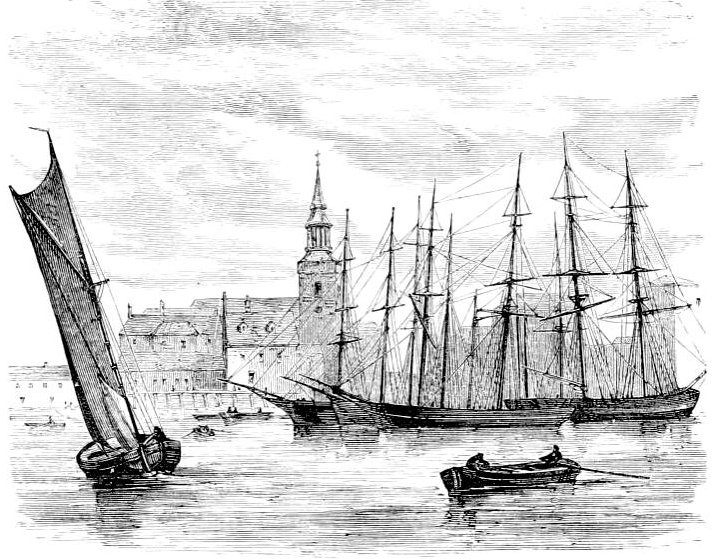
Rotherhithe Church; Tunnel Pier. Engraving of a drawing by Walter W. May, R.N. 1859. From The Book of the Thames from its Rise to its Fall, p. 471. Text and formatting by George P. Landow. [You may use this image without prior permission for any scholarly or educational purpose as long as you (1) credit the University of Pittsburgh and the Internet Archive and (2) link your document to this URL in a web document or cite the Victorian Web in a print one.]
Towards the middle of the seventeenth century building commenced in this quarter; it has increased, until Rotherhithe has been joined to Southwark by streets. Rotherhithe is a town of very ancient foundation, and some etymologists derive its name from two Saxon words, signifying "the Sailor's Haven." It was originally part of the royal manor of Bermondsey, and the residence of some of our early kings. Edward III here fitted out one of his fleets. It is now chiefly remarkable for the Commercial Docks, which are said to occupy the trenches first cut by Canute in the eleventh century, and which extended to Battersea, thus turning Southwark into a sort of island, as a defence against attacks in that quarter. The docks are five in number, and comprise about sixty acres of water and forty of land, and they have immense granaries near them. Close beside Rotherhithe Church is the entrance to the Thames Tunnel, which unites the banks of the river by an underground communication, consisting of a double passage, conjoined by a central arcade lit with gas, with footways on each side for pedestrians, and a carriage-way; but as it would require a very lengthy inclined plane to the mouth of the Tunnel on each side, that part of the scheme has never been carried out: foot passengers descend by a well-staircase. Each archway is about 20 feet in height; the entire width of the Tunnel is 35 feet, and at high water it is 75 feet below the surface. It was planned by the late Sir Isambard Brunel in 1823; and on the 20th of March, 1843, it was first opened to passengers. It is kept open day and night, the toll being one penny; and, on some occasions, a kind of fancy fair has been held in it.
From the Tower to the entry to this Tunnel, at Wapping, the Thames is lined with warehouses, wharves, and docks. Of the latter, the most important are St. Katherine's Docks, in close contiguity to the Tower. They take their name from the old hospital dedicated to St. Katherine, which once stood on this site, and which was founded by Matilda, the wife of King Stephen, a.d. 1148. When the old building was pulled down in 1827, the hospital and church were rebuilt in the Regent's Park. The docks were begun in May, 1827, and finished in October of the following year — a gigantic work, completed in an incredibly short time, by the continuous labour of 2500 workmen. The lock from the Thames has greater depth of water than any other dock-entry; it is 28 feet at some tides, and ships of 700 tons burthen can always enter. The warehouses surrounding it are on a gigantic scale, and are specially secure, owing to the lofty walls surrounding them. These docks were planned by the great engineer, Telford, and constructed by Hardwick, at a cost of £1,700,000. [471-73]
Related Material
- Rotherhithe to Wappings Tunnel — view of the Western archway (1836)
- Plan of the Tunnel with reference to the main roads and objects on the eastern part of London
- The Tower Subway under the Thames (1870)
Bibliography
Hall, Samuel Carter, and A. M. Hall. The Book of the Thames from its Rise to its Fall. London: Arthur Hall, Virtue, and Cp., 1959. Internet Archive version of a copy in the William and Mary Darlington Memorial Libray, the University of Pittsburgh. Web. 10 March 2012.
Created 11 March 2012
Last modified 8 December 2021